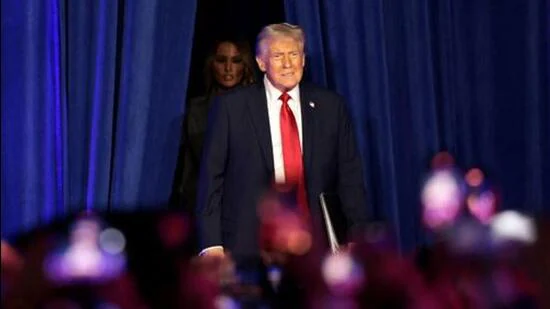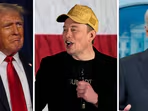Explained: How Donald Trump won
Donald Trump’s remarkable political win was based on a clever selection and aggregation of political issues, astute targeting of both the base and newer demographic groups, and a relatively focused and disciplined campaign machinery.

Based on HT’s extensive reporting from the Republican National Convention in Milwaukee, its ground reporting from swing states in the past fortnight, and conversations with aides in Trump’s ecosystem, it is clear that the Republican win in 2024 represents a much larger structural shift in American politics than Trump’s 2016 win.
Indeed, Trump’s win is akin to Narendra Modi’s spectacular wins in 2014 and 2019 that legitimised the Bharatiya Janata Party’s (BJP) ideological worldview, expanded the party’s social coalition, and introduced a new way of campaigning. Let us examine each of these elements in the American context separately.
The promise of a better life
Borrowing from another legendary Republican president Ronald Reagan, Trump’s campaign rested on a simple question to American voters; was their life better off now, or was it better off under Trump? For many, the answer was that it was indeed better under Trump, despite the devastation caused by the pandemic under his watch, for which, like Indian voters, Americans forgave the government and attributed it to factors outside anyone’s control.
Also Read: Donald Trump’s miraculous political comeback
Quantifying how life was better boiled down to four factors.
The first was inflation. From the young and old, from Whites and Blacks and Hispanics, from men and women, on the campaign trail, HT repeatedly heard a common refrain; inflation in the past four years had been crushing. Gas, grocery, and housing prices cumulatively meant that Joe Biden’s otherwise credible economic record didn’t trickle down to what citizens felt in their everyday lives. If there was a single driver of Trump’s win, it was probably high prices. And the Republican campaign smartly focused on this question in most of its messaging, attributing blame to Biden and promising lower costs under Trump.
The second was immigration. Trump had made stopping the flow of people illegally through the southern border a policy priority in 2016 as well. This time around, he argued, and rightly so, that there had been a massive spike in illegal immigration under the Biden administration. He then, not so accurately, suggested that immigrants were criminals and from “mental institutions”, that they were the reason why prices were so high, that they were attacking local communities (including making bizarre claims about immigrants eating pets), and promising the biggest mass deportation exercise in American history. This argument served several purposes. To moderates, it seemed entirely reasonable that America should have secure borders; to White supremacists, the issue offered a cover to couch their racist opposition to immigrants; and to legal migrants from minority communities, the rhetoric seemed directed at those who came in illegally and not them.
Also Read | Abortion to Zelensky: The A-Z of the US presidential elections
The third was foreign wars. It is striking how exasperated American voters are with America’s external entanglements. From the northern edge of Pennsylvania to the southern edge of North Carolina, from the diners in Tennessee to even the neighbourhoods in DC’s Capitol Hill, HT repeatedly heard voters ask why the US was wasting resources abroad when it had so much work to do at home. There may have been specific interest groups who did not like the US’s position on Gaza or Ukraine or Afghanistan, and all of that added to the result, but at the root of it was the overwhelming desire to disengage from global uncertainties to whatever extent was possible. And Trump offered exactly that by pointing to voters that neither had Russia attacked Ukraine nor had Hamas attacked Israel under him, and promising an end to wars and America’s involvement in them. This tied in seamlessly with Trump’s projection of strength.
And the final issue was the pedagogy around sexuality. The Trump campaign tapped into a deep, often unfounded, fear among parents that their children were being subjected to a certain kind of indoctrination about sexuality in schools at an early stage, and that they even could return home one day after a gender reassignment surgery without any parental consent. It spent extraordinary resources in advertising with a simple message -- should men play in women’s sport? All of this was meant to both scare voters, especially those uncomfortable with the pace of social change in certain urban pockets on the coast, and reassure them that under Trump, their children would be safe and a man would be a man and a woman would be a woman. The message resonated.
If prices were lower, immigration was lower, America wasn’t entangled in wars, and kids were safer, life was better, wasn’t it? That was Trump’s core USP. To draw a contrast, Trump then suggested that on prices, Kamala Harris would only continue Biden’s policies; on immigration, she was responsible for the mess as a “border czar”; on wars, she represented a continuity with America’s “globalist” thinking; and on sexuality, she was as “woke” or radical left” as they came. And that is why, the argument went, he could recreate the American dream in a way that she couldn’t. This was his version of the “achhe din” chant of 2014 in India.
Expanding the social coalition
Messaging, as the Indian electoral experience has shown, is not enough unless it is accompanied by a careful targeting of demographic groups. And just like the BJP in 2014 and 2019 succeeded because it got a maximum share of its core vote but supplemented it with unprecedented inroads into Hindu subaltern groups, the Republicans succeeded because of a combination of core support and new inroads.
The Republican Party is fundamentally a White and Christian formation. This is visible in the composition of their leadership, of their party officials, of their voters, and in the policy issues that appear to animate them and the rhetoric that is used in the party rallies. By offering patronage to White supremacist groups who peddle the Great Replacement Theory that suggests an organised conspiracy to change American demographic patterns, or by breaking the Church-State separation by promising a free run to White Christian evangelists in policy and law, Trump caters to this base.
But where he has been different is adding a layer of class-based differentiation within the White vote, and showcasing the Republican party as a party of the working class rather than a party of merely billionaires and financiers and the Wall Street types as it had come to be seen under previous leaders. The fact that the head of Teamsters, a major union, spoke at the party convention or that Trump remains focused on bringing manufacturing back is proof of this approach.
There is little doubt that in this election, Trump got a majority of votes among both White men and White women. The political genius, however, has been supplementing this White vote with increased support among all minority communities. Counter-intuitive as it may sound, more Black men supported Trump than they supported any Republican candidate in the past, even when a Black woman was standing against him. More Hispanic men supported him than they supported any Republican in the past, even though a lot of the anti-immigrant rhetoric was directed at Latinos. And even more Indian-American men supported him than they have supported any Republican candidate in the past, despite his religious conservativism and stance on immigration.
All of this stemmed from various reasons. The same issues that resonated with other voters — economy and immigration and foreign wars and opposition to “woke politics” — resonated with voters from minority communities. The same hyper masculine Republican campaign that worked for White men worked for men of other communities. In the case of Blacks and Hispanics, there was a degree of religious commonality with the conservative White Christian worldview. In the case of Hispanic and Indian-American legal immigrants, there was a similar disdain for illegal immigrants. All of this shows that boxing identity groups and treating them as loyal voting blocs based on identity grievances of a certain kind isn’t a recipe for success.
The bottom line was that even as the Republican social coalition expanded, the Democratic social coalition shrunk. And if you can keep your base, and eat into another party’s base, your chances of winning improve. That’s what happened.
Campaign and communication
But to get the message out and win over social groups, what a political leader eventually needs is a campaign infrastructure — what, in the Indian parlance, is the power of the sangathan, or organisation.
Trump, not known for either being a man given to organisation or discipline, when faced with his most serious political challenge, changed his approach partly. He picked Susan Wiles to run his campaign. An old Florida Republican operator, Wiles, and another campaign aide, Chris LaCivita, brought a certain degree of competence to the campaign that Trump’s earlier forays had lacked. This included carefully examining data, adapting the messaging accordingly, forcing Trump to stay on script whenever possible, building up ground operations, raising and spending money smartly, communicating with voters where they were including through newer mediums such as podcasts, mediating between different leaders and factions and groups that sought Trump’s attention, and forcing the former president to often resist his worst impulses.
It also meant relying on a parallel communication infrastructure. To regain credibility after the 2020 result, Trump continued discrediting existing media platforms, and promoted a set of parallel anchors, journalists and writers. From Fox to New York Post; from Tucker Carlson, who runs his shows on X after being forced out of Fox, to Charlie Kirk, whose podcast reportedly is downloaded half a million times every day; from Steve Bannon, who went to prison for contempt of Congress and said he believed in “unrestricted narrative warfare”, to Trump’s own Truth Social platform; from the Elon Musk-owned X to the Ben Shapiro Show, Trump’s supporters consume information through these mediums. These outlets will fail any test of media impartiality, rigour, and factual accuracy. But that’s the point. They don’t pretend to be independent or factual media but believers of a political movement handling the narrative branch of the movement. It is the Carlsons, Kirks, Bannons, Shapiros, Joe Rogans and their ilk who have ensured that the Republican base believes the version of truth that Trump has put forward from 2020.
And finally, the Trump sangathan’s most risky foray was in outsourcing the “get out the vote” operations to independent groups such as Musk’s Americas Political Action Committee and Kirk’s Turning Point Action. It was not the traditional Republican Party but these groups which hired people, paid them generously, and got them to canvas on the ground, ensure that the base turned out, and go to fence sitters. It worked.
Donald Trump’s victory is a textbook case of how political messaging, political coalition-building, political communication, and political organisation can come together to deliver a political victory even in the most challenging and unlikely of circumstances. That is a remarkable testament to the innate political instincts of a man who joined politics less than a decade ago.
Disclaimer: The copyright of this article belongs to the original author. Reposting this article is solely for the purpose of information dissemination and does not constitute any investment advice. If there is any infringement, please contact us immediately. We will make corrections or deletions as necessary. Thank you.
Title:Explained: How Donald Trump won
Url:https://www.investsfocus.com









